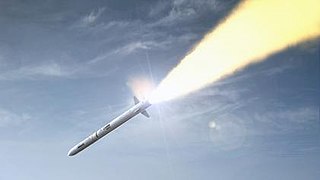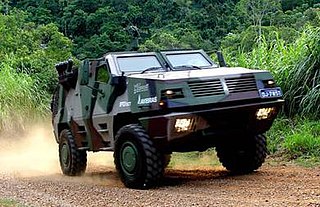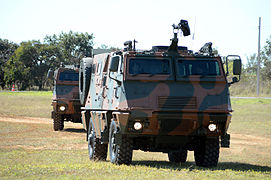
A missile is an airborne ranged weapon capable of self-propelled flight aided usually by a propellant, jet engine or rocket motor.

An air-to-surface missile (ASM) or air-to-ground missile (AGM) is a missile designed to be launched from military aircraft at targets on land or sea. There are also unpowered guided glide bombs not considered missiles. The two most common propulsion systems for air-to-surface missiles are rocket motors, usually with shorter range, and slower, longer-range jet engines. Some Soviet-designed air-to-surface missiles are powered by ramjets, giving them both long range and high speed.

The Polyphem was a proposed European light-weight fibre-optic wire-guided surface-to-surface missile with a range of 60 km. The project was cancelled in 2003.

The 9K121 Vikhr is a Soviet laser-beam-riding anti-tank missile. "9K121" is the GRAU designation for the missile system. The missile can be launched from warships, Ka-50 and Ka-52 helicopters, and Su-25T aircraft. It was first shown publicly at the 1992 Farnborough Airshow.

Astros II is a self-propelled multiple rocket launcher produced in Brazil by the Avibras company. It features modular design and employs rockets with calibers ranging from 127 to 450 mm. It was developed on the basis of a Tectran VBT-2028 6×6 all-terrain vehicle for enhanced mobility based on Mercedes-Benz 2028 truck chassis while later versions use Tatra 815-7 chassis.
List of abbreviations, acronyms and initials related to military subjects such as modern armour, artillery, infantry, and weapons, along with their definitions.

The CAMM is a family of surface-to-air missiles developed by MBDA UK for the United Kingdom. CAMM is derived from, and shares some common features and components with, the Advanced Short Range Air-to-Air Missile (ASRAAM), but with updated electronics, a soft vertical launch system, and an active radar homing seeker. The CAMM family is either currently in-use or has been ordered by ten nations.

ALAS is a Serbian long-range multipurpose wire guided missile system developed by the private company EdePro and the state-owned Yugoimport SDPR. The ALAS missile system was developed primarily for missions against tanks, armored vehicles, fortifications, command posts, low-flying helicopters, coastal ships, industrial facilities and bridges. It can be deployed by any suitable platform including helicopters, armored vehicles, small ships and infantry. The guidance system is based on video/infrared technology, with the missile connected to the launcher by a fiber-optic cable. The ALAS flies at low altitude and has small radar and infrared (heat) signatures due to using a turbofan motor instead of a turbojet. In recent years, the ALAS platform has found a secondary use as a UAV.

FOG-MPM(Fiber Optics Guided Multiple Purpose Missile) is a missile built by the Brazilian company Avibras. Its range is about 60 km. The weight is about 34 kg. Its main use is as an anti-tank, anti-fortification and anti-helicopter missile. FOG-MPM is guided by optical fiber technology. The FOG-MPM is very flexible, can be launched from ground vehicles (Astros II MLRS), ships and helicopters, and is immune to electronic measures.

The AV-TM 300 Tactical Missile or MTC-300 is a Brazilian cruise missile developed by Avibras for the Astros II system. Nicknamed Matador ("killer"), it is projected to be a less expensive alternative to the American BGM-109 Tomahawk. The missile is equipped with a central computer that combines a Ring laser gyroscope, connected to an active GPS navigation device that uninterruptedly supplies positioning information for course correction. Apparently there also will be a naval version called X-300. The missile can use a single warhead of 200 to 500 kg high explosive or cluster munition warhead with 64 submunitions for anti-personnel or anti-tank targets.

National Anti-Ship Missile also named AV-RE40 —previously known as MAN-1—is a US$75 million anti-ship missile project under development by Avibras, Mectron, Atech and Omnisys for the Brazilian Navy. The design aims to achieve performance similar to MBDA MM40 Exocet Block II. It is expected to begin field tests in 2017, and should begin production around late 2018 or early 2019.

The Raytheon MGM-157 EFOGM was a long-range enhanced fiber optic guided missile developed for the U.S. Army during the 1980s and 1990s to test the use of fiber optics in missiles. The missile was launched vertically and manually controlled by an operator on the ground by use of a television camera mounted on the nose. The signals from the camera were carried via a thin wire that unspooled the further up the missile reached. The weapon was primarily designed for anti-tank use, or against low flying helicopters.

The AV-VB4 RE 4×4 GUARÁ is an armoured personnel carrier manufactured and developed by the Brazilian company Avibrás and tested in Haiti. It holds a crew of four and six passengers, and weighs 7.65 tonnes. GUARÁ was developed from the chassis of the German off-road vehicle UNIMOG 4000, whose platform met some important requirements, such as the ability of high-speed roads (97 km/h) and to go over various terrains, to be transported by rotary and fixed-wing aircraft, maintaining a radius of 600 km, easy maintenance and good logistic dependence, low ground pressure, great tactical mobility and the option to be equipped with additional armor, a spacious interior and yet to have a relatively light weight of 7650 kg in standard configuration. Several versions were planned, of which the most significant were: Command Post, anti-tank equipped with missiles and radar, forward reconnaissance, mortar carrier, Ambulance, UNO etc..

Fogtrein, is the name given to a family of Brazilian research rockets created jointly by the Air Force Command (COMAer) and Avibras.
BRE is a series of guided rockets (missiles) manufactured by Chinese Norinco.
The Brazilian Army has a large number of active and planned projects, under the modernization plans of the Brazilian Armed Forces, defined in the National Defense White Paper. From 2010, Brazil started a radical change in its military policy, aiming to consolidate itself as the major power of Latin America.

The Brazilian Air Force has a large number of active and planned projects, under the modernization plans of the Brazilian Armed Forces, defined in the National Defense White Paper. From 2010, Brazil started a radical change in its military policy, aiming to consolidate itself as the major power of Latin America.


















